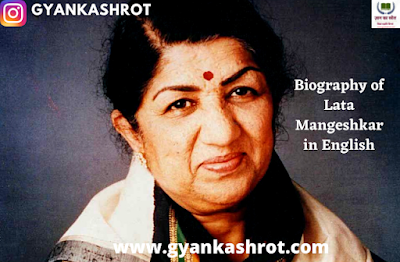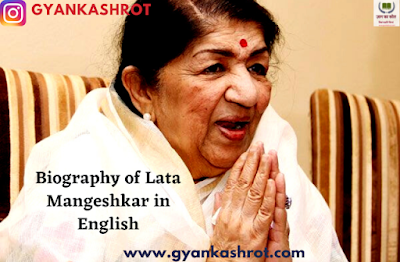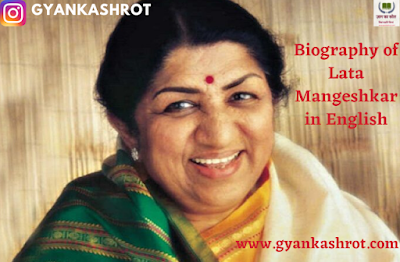Lata Mangeshkar is a well-known singer from India. Lata Mangeshkar, the legendary vocalist, was born on September 28, 1929, in Indore, India. She is a playback singer and music director from India. She is one of India's most well-known playback singers. Let's have a look at her biography, which includes information about her age, family, education, singing career, awards, and honours, among other things.
Lata Mangeshkar's Biography:
Legendary vocalist Lata Mangeshkar is one of India's most well-known and renowned playback singers, having recorded songs for over a thousand Hindi films. Her fame stems from the fact that she has a pleasant and engaging voice.
Lata Mangeshkar began her career in 1942 at the age of 13 and has since sung over 30,000 songs in various Indian languages. She is regarded as one of India's greatest singers and was awarded the Bharat Ratna, the country's highest civilian honour, in 2001.
She was born in the Indian city of Indore on September 28, 1929. She was the oldest of a family of five children. Pandit Deenanath Mangeshkar was her father, and Shevanti was her mother. His father, Master Dinanath, was a well-known Marathi theatre personality.
She was first exposed to music at a young age. She recorded her debut song for Vasant Joglekar's Marathi film Kiti Hasaal when she was 13 years old.
"Hema" was Lata Mangeshkar's given name when she was born. Her parents later changed her name to Lata in honour of a female character named Latika in one of her father's plays, BhaawBandhan. Meena, Asha, Usha, and Hridaynath are her siblings' names in order of birth. They're all talented vocalists and musicians. Her educational background isn't well-known, but she demonstrated that a degree isn't the only way to make money. Her father was the one who gave her her first music instruction. She began working as an actress in her father's musical productions when she was five years old.
Her Musical Journey and Singing Career
She was the singing voice for a slew of Bollywood leading ladies during the course of her six-decade career. Without a doubt, she made a huge impact on Indian film music. Since 1942, Lata Mangeshkar has pushed the boundaries of music with her mind-boggling abilities.
Lata Mangeshkar's early career in the 1940s and 1950s
In 1942, Lata Mangeshkar's father died of a heart attack when she was 13 years old. Master Vinayak or Vinayak Damodar Karnataki, the owner of the Navyug Chitrapat movie studio, looked after them. He was a close associate of the Mangeshkar. He aided Lata in launching her career as a singer and actress.
Lata Mangeshkar's song "Naachu Yaa Gade, Khelu Saari Mani Haus Bhaari" was released in 1942. Sadashivrao Nevrekar composed it for Vasant Joglekar's Marathi film Kiti Hasaal. The song was deleted from the final version. Vinayak also had a brief role in Navyug Chitrapat's Marathi film Pahli Mangalaa-gaur, in which she sang "Natali Chaitraachi Navalaai." Dada Chandekar composed the piece. Her debut Hindi song was "Mata Ek Sapoot Ki Duniya Badal De Tu."
She struggled as a teenager to support her family. In the 1940s, she made a name for herself as a playback vocalist in the Hindi cinema industry. In 1945, she relocated to Mumbai. She began receiving Hindustani classical music instruction from Ustad Aman Ali Khan of the Bhindibazaar Gharana. She sang the song "Paa Lagoon Kar Jori" for the film Aap Ki Seva Mein (1946), which was composed by Datta Davjekar. Lata and her sister Asha both had minor roles in the 1945 film Badi Maa. She also performed the Bhajan "Mata Tere Charnon Mein" in this film.
Vinayak died in 1948, and Ghulam Haider, the music director, groomed her as a singer. Sashadhar Mukherjee, the producer, was introduced to Lata by him. Her destiny was decided when she recorded the hit "Uthaye ja unke sitam" in Andaz (1949). From Nargis and Waheeda Rehman through Madhuri Dixit and Preity Zinta, she gave her musical voice to every significant leading lady, representing every age of Hindi cinema.
Mahal (1949), Barsaat (1949), Meena Bazaar (1950), Aadhi Raat (1950), Chhoti Bhabhi (1950), Afsana (1951), Aansoo (1953), and Adl-e-Jehangir (1953) were among the commercial films in which she sang (1955).
She also sang for Naushad in films like as Deedar (1951), Baiju Bawra (1952), Amar (1954), Uran Khatola (1955), and Mother India (1956). (1957). Ae Chorre Ki Jaat Badi Bewafa, a duet with G. M. Durrani, was her first song for composer Naushad. Shankar–Jaikishan cast Lata in Barsaat (1949), Aah (1953), Shree 420 (1955), and Chori Chori (1959), among other films (1956).
S.D. Burman chose Lata as the primary female singer in his musical scores for Sazaa (1951), House No. 44 (1955), and Devdas (1957) before 1957. (1955). Lata Mangeshkar and R. D. Burman fell out in 1957, and she didn't sing his works again until 1962.
For Salil Chowdhury's composition "Aaja Re Pardesi" from Madhumati, she received the Filmfare Award for Best Female Playback Singer (1958). She appeared in films directed by Madan Mohan, including Baagi (1953), Railway Platform (1955), Pocketmaar (1956), Mr. Lambu (1956), Dekh Kabira Roya (1957), Adalat (1958), Jailor (1958), Mohar (1959), and Chacha Zindabad (1959). (1959).
Lata Mangeshkar's Singing Career in the 1960s, 1970s, and 1980s
How can we forget Mughal-e-song Azam's "Pyar Kiya To Darna Kya"? (1960). This song was masterfully sung by Lata Ji, and it has remained in everyone's heart ever since. Madhubala lip-synced it after Naushad penned it. Also, Lata Ji sang "Ajeeb Dastaan Hai Yeh" from Dil Apna Aur Preet Parai (1960), which is one of my favourite songs. Shankar–Jaikishan composed it, and Meena Kumari lip-synced it.
Lata Mangeshkar recorded two classic bhajans for Burman's assistant, Jaidev, in 1961: "Allah Tero Naam" and "Prabhu Tero Naam." In 1962, she won her second Filmfare Award for Hemant Kumar's composition "Kahin Deep Jale Kahin Dil" from Bees Saal Baad.
In January 1963, Lata Ji performed a patriotic song against the backdrop of the Sino-Indian War. In the presence of Jawaharlal Nehru, India's Prime Minister at the time, the song was "Aye Mere Watan Ke Logo." The song is claimed to have moved former Prime Minister Jawaharlal Nehru to tears. C. Ramchandra composed the song, which was written by Kavi Pradeep.
In 1963, Lata Ji reunited with S. D. Burman for another collaboration. She subsequently went on to sing in R.D. Burman's debut film, Chhote Nawab (1961), as well as later films like Bhoot Bungla (1965), Pati Patni (1966), Baharon Ke Sapne (1967), and Abhilasha (1968). (1969).
"Aaj Phir Jeene Ki Tamanna Hai," "Gata Rahe Mera Dil" (duet with Kishore Kumar), and "Piya Tose" from Guide (1965), "Hothon Pe Aisi Baat" from Jewel Thief (1967), and "Kitni Akeli Kitni Tanhaa" from Talash were among the popular songs she recorded.
"Aap Ki Nazron Ne Samjha" from Anpadh (1962), "Lag Jaa Gale" and "Naina Barse Rim Jhim" from Woh Kaun Thi? (1964), "Woh Chup Rahen To" from Jahan Ara (1964), "Tu Jahan Jahan Chalega" from Mera Saaya (1966), and "Teri Aankho Ke Siva" from Chirag (1969).
In the 1960s, Lata Ji began her collaboration with Laxmikant-Pyarelal, the music director for whom she performed the most popular songs.
Over the course of 35 years, she is believed to have performed over 700 songs for the composer couple, many of which became hits. She sung in films such as Parasmani (1963), Mr. X in Bombay (1964), Aaye Din Bahar Ke (1966), Milan (1967), Anita (1967), Shagird (1968), Mere Hamdam Mere Dost (1968), Intaquam (1969), Do Raaste (1969), and Jeene Ki Raah (1969). She won her third Filmfare Award for this performance.
She sang various Marathi film playback songs. She also sang numerous Bengali songs in the 1960s and 1970s. During the 1960s, she sang duets with Kishore Kumar, Mukesh, Manna Dey, Mahendra Kapoor, and Mohammed Rafi.
Meena Kumari's final film, "Chalte Chalte," was released in 1972 and featured popular songs such as "Chalte Chalte" and "Inhi Logon Ne," which were sung by Lata Ji and composed by Ghulam Mohammed.
She also recorded popular songs for S.D. Burman's final films, including "Rangeela Re" from Prem Pujari (1970), "Khilte Hain Gul Yahaan" from Sharmeelee (1971), and "Piya Bina" from Abhimaan (1973), as well as Madan Mohan's final films, including Dastak (1970), Heer Raanjha (1970), Dil Ki Rahen (1973), Hindustan Ki Kas (1976).
In the 1970s, Laxmikant-Pyarelal and Rahul Dev Burman composed a number of songs for Lata Mangeshkar. She also co-wrote and co-wrote successful songs with Rahul Dev Burman for films such as Amar Prem (1972), Caravan (1971), Kati Patang (1971), and Aandhi (1972). (1975). Majrooh Sultanpuri, Anand Bakshi, and Gulzar are among the lyricists who have collaborated with the two.
For the song "Beeti Na Bitai" from the film Parichay, she got a National Film Award for Best Female Playback Singer in 1973. R.D. Burman composed the music, and Gulzar wrote the lyrics. In 1974, she sang the Malayalam song "Kadali Chenkadali" for the film Nellu. It was penned by Vayalar Ramavarma and composed by Salil Chowdhury.
In 1975, she received another National Award for the song "Roothe Roothe Piya" from the film Kora Kagaz, which was composed by Kalyanji Anandji. She also organised a number of performances, including several charity events, beginning in the 1970s. She performed her first concert in the Royal Albert Hall in London in 1974, making her the first Indian to do so.
"Chala Vaahi Des," an album of Mirabai's Bhajans, was also issued by her. Hridaynath Mangeshkar composed the music.
In 1978, Rak Kapoor directed Satyam Shivan Sundaram, in which Lata Ji sung the main theme song "Satyam Shivam Sundaram," which became the year's biggest hit.
She collaborated with composers such as Rahul Dev Burman, son of Sachin Dev Burman, Rajesh Roshan, Anu Malik, son of Sardar Malik, and Anand–Milind, sons of Chitragupta in the late 1970s and early 1980s. Several songs were also sung in the Assamese language. Rudaali (1993)'s song "Dil Hoom Hoom Kare" had the biggest record sales that year.
She sang for films such as Karz (1980), Ek Duuje Ke Liye (1981), Silsila (1981), Prem Rog (1982), Hero (1983), Pyar Jhukta Nahin (1985), Ram Teri Ganga Maili (1985), Nagina (1986), and Ram Lakhan (1986) beginning in the 1980s (1989). At the time, her song "Zu Zu Zu Yashoda" from Sanjog (1985) was a hit.
She also performed for Tamil films in the late 1980s. In the 1980s, Lata ji's biggest hits included "Sheesha Ho Ya Dil Ho" in Asha (1980), "Tu Kitne Baras Ka" in Karz (1980), "Kitna Aasan Hai" in Dostana (1980), "Hum Ko Bhi Gham" in Aas Paas (1980), "Mere Naseeb Mein" in Naseeb (1980), "Zindagi Ki Na Too (1989).
Bappi Lehri also composed songs for Lata Ji, including "Dooriyan Sab Mita Do" in Saboot (1980), "Baithe Baithe Aaj Aayi" in Patita (1980), "Jaane Kyun Mujhe" in Agreement (1980), "Thoda Resham Lagini Hai" in Jyoti (1981), "Dard Ki Ragini" in Pyaas (1982), and "Naino (1983).
She also had hits in the 1980s, such as "Sun Sahiba Sun" in Ravindra Jain's Ram Teri Ganga Maili (1985), "Chand Apna Safar" in Shama (1981), "Shayad Meri Shaadi" and "Zindagi Pyar Ka" in Souten (1983), and "Hum Bhool Gaye Re" in Usha Khanna's Souten Ki Beti (1989). "Kale Kale Gehre Saye" in Chakra (1981), "Ye Ankhen Dekh Kar" and "Kuchh Log Mohabbat Ko" in Dhanwan (1981), "Mujhe Tum Yaad Karna" in Mashaal (1984), "Jonakore Rati" (1986) for Amar-Utpal, "Jaane Do Mujhe" in Shahenshah (1989) for Amar-Utpal Uttam Jagdish starred in Jamuna Saraswati (1988) and Waaris (1989) in "Mere Pyar Ki Umar."
Lata Mangeshkar was asked to perform at Maple Leaf Gardens by the United Way of Greater Toronto in June 1985. She performed the song "You Needed Me" on stage. Around 12,000 people attended the show.
The career of Lata Mangeshkar in the 1990s and 2000s
She worked with a variety of music directors during the 1990s, including Anand-Milind, Nadeem-Shravan, Jatin-Lalit, and others. She also established her own Hindi film production firm in 1990, which produced the Gulzar-directed film. Lekin..... For the song "Yaara Sili Sili," she got her third National Film Award for Best Female Playback Singer. Hridaynath, her brother, penned it.
She has performed in practically all of Yash Chopra's films as a singer. During this time, A. R Rahman collaborated with her on a few songs, including "Jiya Jale" in Dil Se.., "Khamoshiyan Gungunane Lagin" in One 2 Ka 4, "Ek Tu Hi Bharosa" in Pukar, "Pyaara Sa Gaon" in Zubeidaa, "So Gaye Hain" in Zubeidaa, and others.
Shraddanjali - My Tribute to the Immortals was also released in 1994. The film's primary highlight is Lata Ji's tribute to legendary singers of the time by singing a few songs in her own voice. She sung "Kuch Na Kaho" for Rahul Dev Burman's final song, 1942: A Love Story, in 1994.
In 1999, Lata Eau de Parfum was introduced as a perfume brand. In the same year, she received the Zee Cine Award for Lifetime Achievement. In 1999, she was also nominated for a seat in the Rajya Sabha.
In 2001, she received the Bharat Ratna, India's highest civilian honour. In the same year, she founded the Master Deenanath Mangeshkar Hospital in Pune. The Lata Mangeshkar Medical Foundation was in charge of it.
She also contributed to the earthquake relief efforts in Kashmir in 2005. For the film Lajja, she also recorded her debut Hindi song with composer Ilaiyaraaja. In the film Eternal Sunshine of the Spotless Mind, her song "Wada Na Tod" was featured (2004). On June 21, 2007, the album Saadgi was released.
The Career of Lata Mangeshkar in the 2010s
On April 12, 2011, she released the album Sarhadein: Music Beyond Boundaries. It includes Mangeshkar and Mehdi Hassan's duet "Tera Milna Bahut Acha Lage." She also recorded "Kaise Piya Se" for composer Nadeem-film Shravan's Bewafaa (2005). Shamir Tandon also recorded a song with her for the film Satrangee Parachute called "Tere Hasne Sai Mujheko" (2011).
She also had a song recorded in her own studio. "Jeena kya hai, jaana maine" was the song for Dunno Y2-Life Is A Moment (2015).
On November 28, 2012, she founded her own music company, LM Music, with a bhajan CD. In 2014, she released a Bengali album. Mayuresh Pai created the song "Saugandh Mujhe Is Mitti Ki," which she published in 2019. It was a gift to the Indian army and the country.
Awards & Recognitions
- 2009 - ANR National Award
- 2007 - Legion of Honour
- 2001 - Bharat Ratna, India's highest civilian award
- 1999 - Padma Vibhushan
- 1999 - Zee Cine Award for Lifetime Achievements
- 1999 - NTR National Award
- 1997 - Maharashtra Bhushan Award
- 1989 - Dadasaheb Phalke Award
- 1972, 1974, and 1990 - Three National Film Awards
- 15 Bengal Film Journalists' Association Awards
- 1959, 1963, 1966, and 1970 - Four Filmfare Best Female Playback Awards.
- 1993 - Filmfare Lifetime Achievement Award
- 1994 and 2004 - Filmfare Special Awards
- 1984 - State Government of Madhya Pradesh instituted the Lata Mangeshkar Award of Lata Mangeshkar
- 1992 - the State Government of Maharashtra also instituted a Lata Mangeshkar Award
- 1969 - Padma Bhushan
- 2009 - She was awarded the title of Officer of the French Legion of Honour, France's highest order
- 2012 - She was ranked number 10 in Outlook India's poll of the Greatest Indian.
She is also a recipient of honorary doctorates from Sangeet Natak Akademi (1989), Indira Kala Sangeet Vishwavidyalaya, Khairagarh, and Shivaji University in Kolhapur.







